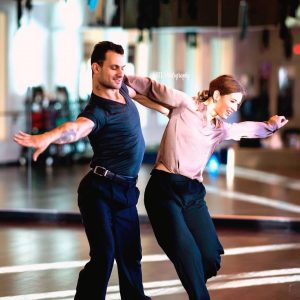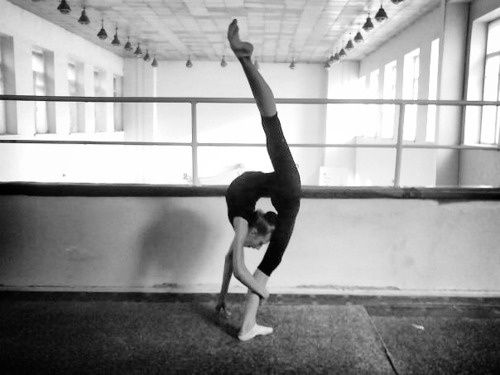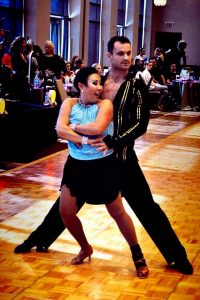Flexibility And The Splits in Ballroom and Latin Dancing
Whatever your goal is in dancing, flexibility is critical. Without it, you are much more prone to injury. With it, you have more options for anything from cleaner looking lines to dramatic splits. Consider these 5 tips for flexibility and the splits to help you with your goals. The first thing to keep in mind is that with care and commitment, almost anyone without a medical restriction can become more flexible that they already are. Your goal at the start may not be full splits, but having a bit more stretch than you have now. Just keep in mind, it will not happen by just dancing more. Like most things in life, you have to have a not only a goal and but also a plan.
The first thing to keep in mind is that with care and commitment, almost anyone without a medical restriction can become more flexible that they already are. Your goal at the start may not be full splits, but having a bit more stretch than you have now. Just keep in mind, it will not happen by just dancing more. Like most things in life, you have to have a not only a goal and but also a plan.
1. Plan a specific and regular time to work on your overall flexibility
~Always warm up before stretching or you will risk injury. Ten minutes of light activity is all you need, or you can do your stretches after your dance practice as part of your cool down.
~You can start with simple extensions of every part of your body:
~Roll your neck while you think of stretching it. Do this by moving your head from side to side while drawing a half circle in the air from one shoulder to the other with your nose. If you want, you can then go a bit further by thinking of drawing as big a circle as you comfortably can with the top of your head. Just remember to keep the neck extended while doing so.
~Reach your arms in every direction as far as they will go. Keep your body still and your shoulder blades down, to isolate the stretch in your arms.
~Extend your legs in various directions while sitting on the floor or on a chair. Keep your hips in a square position with your sides at right angles to the ground, and the base of your pelvis flat, not tilted up or back. Alternate between pointing your toes and flexing your ankles.
~Stretch your sides by turning your upper body while your hips remain square and facing front, and your head remains still. Think of pointing one elbow exactly in front of you and the other exactly behind, then switching.
~Try extending your torso by thinking of lengthen your spine by an inch. Do this with your shoulder blades down and your spine flat. To make sure that your spine is flat, start by standing with your back against a wall if you need to, making sure that there are little or no spaces between your back and the wall. It is interesting how many people feel awkward with a truly straight spine, so do not be surprised if it takes a while before this feels natural to you.
~Hold each extended position for at least a minute to start, and increase the time as you can.
 2. Try to get those feelings of stretch when you dance, and in your daily life
2. Try to get those feelings of stretch when you dance, and in your daily life
~The simple stretches noted above should feel great to you, and will make it clear to you how little we actual stretch our bodies in daily life.
~There are several easy stretches that are great. Each of the ones selected are simple enough to do anywhere and can be used as you dance, to enhance your look.
~Consistency in stretching is key. You need to focus time on this at least 10 mins everyday in addition to incorporating your stretching into your daily life. Any effort that is inconsistent, will not yield much benefit. Even starting at 5 mins every day is better than 15 mins every once in a while. The more consistent you are, the better you will feel, and the faster your flexibility will build.
3. Once the general stretches are comfortable, you can set a specific goal that is within your reach.
~Do not set you goal nor measure your progress based on what you see in someone else. Everyone is born with slightly different types of flexibility in addition to different levels. As well, just because you are flexible in one area of your body, does not necessarily mean that you will be just as flexible in another.
~If you are not sure where to start for your specific goal, ask your coach what would benefit you the most.
~Many people have goals of greater flexibility in hips and hamstrings to do high kicks, long strides and splits, so we will cover that next.
4. Preparing your body to do the splits.
~Generally speaking, it is easier to start with the kind of splits where one leg is in front of the other as opposed to both legs out at each side. With this, it is best to start with the front splits.
~Only try the side splits when your hip flexors and hamstrings are both extremely flexible and very strong. You will know when you are ready for this when the front splits are very easy for you, no matter which leg is in front.
~Lunges and squats are a great way to start preparing for the front splits and training you to keep your hips square and facing front as you stretch.
~It is also beneficial to stretch the quadriceps. You can do this by pointing your bent knee to the floor and holding your foot behind you.
~When you are ready to get into the split position, lower your body as far as you can without pain, while keeping your legs straight or knees slightly soft (not bent) and your hips facing forward.
~To progress, you need to push to the point of being uncomfortable, but never, ever, ever to the point of pain.
~Hold the position for at least 2 minutes. You might need to work up to this, but the 2 minute point is the point where you will get the most benefit.
~Stay completely still. Never bounce. It will not help you and you may injure yourself.
 5. Use it or lose it
5. Use it or lose it
~No matter what level of flexibly you have, you can keep it for a lifetime if you are in good health and you practice your flexibility consistently.
~You can also lose even great flexibility very quickly if you don’t actively do things to maintain it.
~Flexibility truly does protect your health as well as enhance your potential in dancing. With this, it is a good investment of a few minutes of time and effort every day.
Author: Miss P [Celebrate DanceSport]
North Shore Dance Society